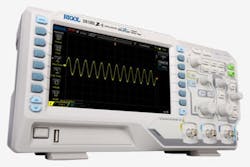How to choose the right oscilloscope for your next project
By Amanda Wilson
NASHUA, N.H. - An excellent device for testing and analysis, an oscilloscope is a must-have for many industries and applications such as RF design, general electronic circuit design, electronics manufacturing, service, repair, and more. Oscilloscopes are commonly used for:
● Testing, measuring and analyzing the characteristics of power conversion devices, circuits, and line-power harmonics.
● Analyzing digital data signals in serial formats such as USB, SCSI, Ethernet, Serial ATA, Fiber Channel, FireWire, Rapid I/O, InfiniBand, Bluetooth and CAN Bus.
● Characterizing and debugging signal jitters and noise in high bandwidths.
● Testing data storage devices and performing clock timing and data stream analysis.
● Detecting faults and variations and troubleshooting with measurement and analysis of parameters such as voltage, impedance, frequency, signal distortion, noise, timing, and more.
Why Is Choosing the Right Oscilloscope Important?
Oscilloscopes are one of the most common pieces of equipment used for electric and electronic applications, second to digital multimeters. When chosen wisely, an oscilloscope can be an extremely reliable tool for testing and measurements, analysis, and troubleshooting. There are various kinds of oscilloscopes available, each suiting a different set of requirements, such as:
● Analog Oscilloscopes
● Digital Storage Oscilloscopes
● Digital Phosphor Oscilloscopes
● Mixed Domain Oscilloscopes
● Mixed Signal Oscilloscopes
● Digital Sampling Oscilloscopes
● Handheld Oscilloscopes
● Computer-Based Oscilloscopes
Analog oscilloscopes have better dynamic range, whereas digital oscilloscopes have better sampling rate limits and bandwidth. Digital storage oscilloscopes can store transient data for future analysis. Digital phosphor oscilloscopes perform signal capture and analysis in a shorter time with the help of a parallel processing ADC solution. Mixed domain oscilloscopes combine the features of digital oscilloscopes, RF spectrum analyzers, and logic analyzers in a single device.
Digital sampling oscilloscopes can capture signals faster than other oscilloscopes with bandwidth exceeding 80 GHz. Handheld oscilloscopes are great for on-field applications, while computer-based oscilloscopes connect to a computer via USB and are preferred in long-term testing scenarios.
Depending on your application, you need to choose a scope with various parameters working for you - bandwidth, storage capabilities, sampling rates, portability, maximum memory depth, waveform update rate, resolution, and so on. You need the right mix to experience the best oscilloscope performance possible.
Important Points to Consider Before Choosing Your Next Oscilloscope
1. Application of the oscilloscope and the types of measurements
- Is the oscilloscope for on-field applications? Should it be easier to carry around and use?
- Would you rather have it in one place for testing?
- Do you need multiple functionalities for your applications such as that of an oscilloscope, an RF spectrum analyzer and a logic analyzer?
- Is the oscilloscope meant for testing high or low bandwidths?
- Do you want to store the data for further use?
2. Your budget
Depending on how much you want to spend on it, and whether you need it for long-term or short-term use, you can either buy, lease or rent oscilloscopes.
3. Buying used oscilloscopes
Used or second-hand oscilloscopes are affordable and can be as much as 90% cheaper compared to new ones. Equipment that has been discontinued by manufacturers can also be found at many test equipment rental inventories for rent, lease, or sale.
When buying pre-owned equipment, keep in mind their conditions and life expectancy, the functionalities offered, and the compatibility of the instrument’s proprietary software with your current operating system.
Factors to Help You Choose the Right Oscilloscope
To make it easier for you, we have listed down some factors that you should consider before buying an oscilloscope.
● Bandwidth
Select an oscilloscope that has sufficient bandwidth to accurately capture the highest frequency of your signals. Remember ‘the five times rule’- select an oscilloscope which, along with the probe, offers at least 5 times the maximum signal bandwidth for better measurements with fewer errors.
● Rise time
Rise times are essential for analyzing square pulses and waves. The rise time of an oscilloscope tells about its measurement accuracy. The faster the rise time, the more accurate the time measurements. Select an oscilloscope whose rise time is < ⅕ times the fastest rise time of your signal.
● Probing
Select an oscilloscope that has multiple specialty probes for your requirements. An oscilloscope can make excellent measurements only if the probe delivers proper inputs to it. A new oscilloscope usually comes standard with a set of high-impedance passive probes. For higher frequency measurement applications, active probes should be used. For a mid-range oscilloscope, choose probes with capacitive loadings of < 10 pF.
● Sample rate
The sampling rate of an oscilloscope determines how well the waveform details can be captured. The higher the sampling rate, the better the resolution, and the faster you use up your memory. Use a sample rate of at least 5 times your circuit’s highest frequency component.
● Triggering
Select an oscilloscope that offers advanced triggering for analyzing even the most complex waveforms. Better triggering options can help you detect challenging anomalies.
● Memory depth
Select an oscilloscope with sufficient acquisition memory for obtaining better resolution for complex signals.
● Number of channels
Select an oscilloscope with a sufficient number of channels of acquisition so that you can perform critical time-correlated measurements for multiple waveforms with ease.
● Easy operation
An oscilloscope with an intuitive and responsive user interface and display for easier operations is recommended. Also, select an oscilloscope that can be connected with other devices easily for advanced functions and simpler documentation of results.
Conclusion
Before selecting an oscilloscope, you should know about your specific testing and measurement needs. Choose an oscilloscope with faster rise times, higher waveform update rates, greater acquisition memory depth, sufficient number of channels, multiple probing options, and suitable bandwidths. Also, look for advanced application support for troubleshooting and standards compliance.
